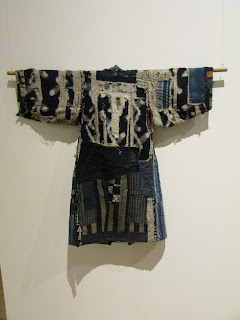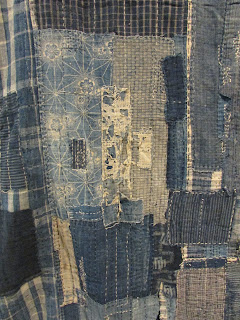Another visit to SOAS' Brunei Gallery for another equally spectacular exhibition of textiles from the amazing collection of Karun Thakar. The last occasion was to see the stunningly embroidered Bagh's from the Punjab (here), with this exhibition though we venture further east to Japan for the beautifully repurposed indigo textiles known as Boro. I first encountered these artfully collaged fabrics in an exhibition at Somerset House (here), and was, and still am taken aback by the nuance and sheer varieties of blue that they are dyed with as well as the random beauty of their layering. 'Boro' are Japanese textiles which have been mended or patched together. The term 'boro' is derived from the Japanese 'boroboro', and translates as 'rags' or 'tattered', also something altered or repaired. This practice emerged in poor, rural farming communities in medieval Japan where clothing and household items were passed down through generations out of necessity. As items of clothing became worn or damaged they were patched or repaired with smaller pieces of fabric with a simple running stitch (a sashiko stitch). This resulted in generational layers of mended fabric which transformed the garment into unique appliqued works of art. The technique was not limited to just clothing, old re-purposed fabrics were also used to create functional objects such as futon covers, blankets and sleeping bags. Many boro items were kept within families as heirlooms. These rural communities had ready access to indigo plants hence the diverse range of rich, deep blue dyes that these items are naturally coloured with. Many 'Boro' pieces are now recognised as a form of art and therefore highly collectable, marketed as 'abstract art' in Western contexts. They are important pieces of Japanese history and culture demonstrating the resilience and creativity shown by ordinary working people with limited resources. The exhibition also features delicate Washi (handmade paper) widely used in the Meiji (1868-1912), and Showa (1926-1989) periods to wrap items such as kimonos, tea storage bags, wrap documents, act as room dividers and floor coverings. Old ledgers were often used to make these objects, and a covering of persimmon paste was used to make the papers waterproof. The textures of these papers as well as the stylised calligraphy inscribed upon them again makes them highly covetable artworks in and of themselves. This was such an inspiring and uplifting exhibition highlighting the importance of recycling within Japanese culture. The exhibition was rounded off perfectly with a visit to the tranquil Zen garden on the rooftop of the gallery exhibition space.
Japanese Aesthetics of Recycling
until 23rd September
Brunei Gallery
SOAS
University of London
Thornaugh Street
Russell Square
London
WC1H










































































No comments:
Post a Comment